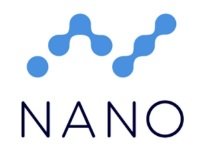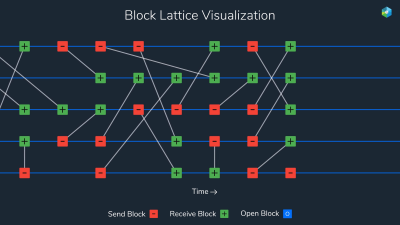
The first in a series of articles about Nano / Raiblocks / XRB / the block lattice.
It's a 7 part series in which we take a deep dive into the block lattice, how it works and why it is a true innovation of blockchain technology. Don't worry, this article is light and just gives you a high level overview with some pros and cons as well as a video demonstration (not my video) of how fast it really works.
I've split it into 7 parts just to keep the topics light (since they can be complicated) while still being able to provide a good in depth view, happy reading!
Index
- Part 1: Introduction
(https://steemit.com/blockchain/@iwan.spillebeen/bockchain-decrypted-the-block-lattice-introduction) - Part 2: In depth
(https://steemit.com/blockchain/@iwan.spillebeen/blockchain-decrypted-the-block-lattice-in-depth) - Part 3: Adaptability / Scalability
(https://steemit.com/blockchain/@iwan.spillebeen/blockchain-decrypted-the-block-lattice-adaptability) - Part 4: Attack Potential
(https://steemit.com/blockchain/@iwan.spillebeen/blockchain-decrypted-the-block-lattice-attack-potential) - Part 5: Block Lattice Visualisation
(https://steemit.com/blockchain/@iwan.spillebeen/blockchain-decrypted-the-block-lattice-visualisation) - Part 6: Network Flooding
- Part 7: Resolving Forks
Introduction
The block lattice is a different and relatively new approach to blockchain technology, developed by the team that launched Nano (formally known as RaiBlocks).
 ->
-> 
The main reason I like this approach is because of their use of the double entry accounting principle that has been tried and tested for many years, which results in a lot of added advantages to traditional blockchain technologies, as well as the block lattice’s scalability and speed.
This blog post outlines the basic principles and characteristics, while subsequent posts will take a deep dive into the block lattice, it’s inner workings, long term adoption possibilities and attack resistance.
In brief:
For every transaction on the network, two blocks are created. A send transaction subtracts from your current account balance and then a receive transaction, confirmed by the recipient, adds to the receiver’s balance.
For the transaction to be completed, the recipient will need to sign the block and broadcast to the network (where voting blocks confirm until you reach 50% vote quorum). These two actions do not have to happen at the same time as the block lattice operates completely asynchronously.

Nano completely cuts out the need of miners by requiring the sender and receiver to verify the transactions which gives tremendous speed advantages. They do have a consensus mechanism in case of conflict, through representative voting, but even this process only takes a matter of seconds and only kicks in at times of conflict, the rest of the time this is dormant (99% o/t time).
Characteristics:
- Each user has his/her own blockchain, I.e. all transactions in this blockchain are controlled by the user of the chain and only the user of the chain
- All these individual blockchains form a brand-new block-lattice architecture
- The lattice achieves consensus by Proof of Stake (PoS) voting
- Proof-of-Work (PoW) exists for transactions, but only on an individual transaction level
- Balances are stored in the blockchain
- Each transaction requires two movements, an outgoing movement and a receiving movement, in two different user blockchains
- It is extremely fast, can handle a large number of transactions per second and is miner-less and fee-less.
Pros
- Enhanced Blake2X hashing algorithm that works with signatures schemes such as EdDSA or RSA-FDH
- Since only the account holder / user can update their own blockchain, it is much easier to see and protect against double spending
- No inherent limit to the number of transactions that can be processed by the system. Transactions are processed individually, and each chain operates asynchronously (highly scalable)
- Seconds to securely complete transactions
- Fee-less (barriers to adoption)
- Miner-less (barriers to use and centralisation)
- Transactions are asynchronous
- Proof of work for spam / Sybil protection;
- The users client app solves a simple cryptographic puzzle in order to send the transaction (spam prevention)
- Representative voting blocks are inactive until there is a conflict (I.e. they shouldn't be active 99% of the time)
- Well written Wiki
Cons
- While easy to read, difficult to understand white paper
- Transactions are not instant, even though they look instant, due to the proof of work puzzle (the puzzle is pre-calculated)
- Voting through representative blocks (users delegate their voting power, similar to EOS), you need a sufficient number of representatives and they need to have sufficient weight each as well as being trusted.
- Two movements per transactions, double the network traffic for a single transaction versus other blockchains (but heightened security!)
- No implementation for smart contracts.
Intrigued? Read my upcoming blog posts for details on how it works exactly, in the mean time take a quick look at their transaction speed from a Nano wallet (Canoe) to a desktop wallet (also Canoe), the video shows you the use of the wallet as well as the transaction speed, don’t blink!
Acknowledgements / References
Artwork:
- Title page “Intelligent Solutions” courtesy of http://www.hloom.com/cover-pages/
- Page header / footer “Abstract blue lights” created by Kotkoa - Freepik.com
Other references:
- https://medium.com/@yourcryptomarketing/raiblocks-the-future-of-bockchain-architecture-no-fees-and-unlimited-scalability-for-all-b2c51a0d80a7
- https://www.reddit.com/user/meor
- https://www.forbes.com/sites/louiscolumbus/2016/11/27/roundup-of-internet-of-things-forecasts-and-market-estimates-2016/#54bb8ea9292d
- https://github.com/clemahieu/raiblocks/wiki/Double-spending-and-confirmation
- https://github.com/clemahieu/raiblocks/wiki/Representatives-and-decentralization
- https://raiblocks.net/page/resources.php#devtools
- https://en.wikipedia.org/wiki/Steganography
- https://hackernoon.com/iota-vs-raiblocks-413679bb4c3e
- https://github.com/clemahieu/raiblocks/wiki/Distribution,-Mining-and-Units
- https://github.com/clemahieu/raiblocks/wiki/Roadmap
- https://github.com/clemahieu/raiblocks/wiki/Attacks
- https://hackernoon.com/visualizing-how-raiblocks-works-8c70678ef082
Contact me
You can contact me here with any questions, suggestions and / or to discuss the topic of this document:
LinkedIn: https://www.linkedin.com/in/iwanspillebeen/
E-mail: iwan@blockchainlabs.ai
CryptoPub/ToshiTimes: https://thecrypto.pub/u/iwan.spillebeen
Sponsoring
I write these papers to - hopefully - help make blockchain more accessible to people new to the technology, I don't get paid, nor sponsored to write these papers. If you absolutely feel inclined to donate something to the writing of this document, you can do so at the following address:
- Ethereum / Ether: 0x6E2a1f9baD495B894A2c6F8240918620F899f4E2
- Nano / XRB: xrb_1xxzi1o9ywinusod35dcun6ku385i33bohhh8hpap76fh67fgnxg1m3qm9mb
Disclaimer
Blockchain – Decrypted is written as a series of chapters, aimed at demystifying the various workings of blockchain technology. Where appropriate I use examples from existing or to-be cryptocurrencies, these examples are just that, examples, and do not aim at promoting or otherwise endorsing any given cryptocurrency.
This document does not constitute legal or financial advice and I do not make any guarantees or promises as to any results that may be obtained from using my content. No one should make any investment decisions without first consulting his or her own financial advisor and conducting his or her own research and due diligence. I disclaim any and all liability in the event any information, commentary, analysis, opinions, advice and/or recommendations prove to be inaccurate, incomplete or unreliable, or result in any investment or other losses.

Hi @iwan.spillebeen
Excellent article. I subscribed to your blog. I will follow your news.
I will be grateful if you subscribe to my blog @user2627
Good luck to you!
Thank you very much, more than happy to follow your blog and interact.
New blog posts on Nano coming up every day this week btw :)
Chapter 4 is now available: https://steemit.com/blockchain/@iwan.spillebeen/blockchain-decrypted-the-block-lattice-attack-potential
Chapter 2 is now available: https://steemit.com/blockchain/@iwan.spillebeen/blockchain-decrypted-the-block-lattice-in-depth
Chapter 3 is now available: (https://steemit.com/blockchain/@iwan.spillebeen/blockchain-decrypted-the-block-lattice-adaptability)
in which we discuss adaptability, scalability and long term adoption.
Chapter 5 is now available: https://steemit.com/blockchain/@iwan.spillebeen/blockchain-decrypted-the-block-lattice-visualisation
Chapter 6 is now available (https://steemit.com/blockchain/@iwan.spillebeen/blockchain-decrypted-the-block-lattice-network-flooding) in which we discuss network flooding and network echo.
Chapter 7 is now available: https://steemit.com/blockchain/@iwan.spillebeen/blockchain-decrypted-the-block-lattice-resolving-forks